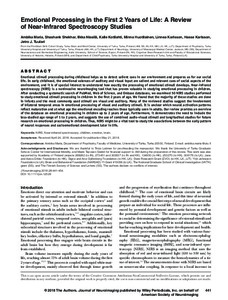Emotional Processing in the First 2 Years of Life: A Review of Near-Infrared Spectroscopy Studies
Maria A; Shekhar S; Nissila I; Kotilahti K; Huotilainen M; Karlsson L; Karlsson H; Tuulari JJ
Emotional Processing in the First 2 Years of Life: A Review of Near-Infrared Spectroscopy Studies
Maria A
Shekhar S
Nissila I
Kotilahti K
Huotilainen M
Karlsson L
Karlsson H
Tuulari JJ
WILEY
Julkaisun pysyvä osoite on:
https://urn.fi/URN:NBN:fi-fe2021042719690
https://urn.fi/URN:NBN:fi-fe2021042719690
Tiivistelmä
Emotional stimuli processing during childhood helps us to detect salient cues in our environment and prepares us for our social life. In early childhood, the emotional valences of auditory and visual input are salient and relevant cues of social aspects of the environment, and it is of special interest to understand how exactly the processing ofemotional stimuli develops. Near-infrared spectroscopy (NIRS) is a noninvasive neuroimaging tool that has proven valuable in studying emotional processing in children. After conducting a systematic search of PubMed, Web of Science, and Embase databases, we examined 50 NIRS studies performed to study emotional stimuli processing in children in the first 2 years of age. We found that the majority of these studies are done in infants and the most commonly used stimuli are visual and auditory. Many of the reviewed studies suggest the involvement of bilateral temporal areas in emotional processing of visual and auditory stimuli. It is unclear which neural activation patterns reflect maturation and at what age the emotional encoding reaches those typically seen in adults. Our review provides an overview of the database on emotional processing in children up to 2 years of age. Furthermore, it demonstrates the need to include the less-studied age range of 1 to 2 years, and suggests the use of combined audio-visual stimuli and longitudinal studies for future research on emotional processing in children. Thus, NIRS might be a vital tool to study the associations between the early pattern of neural responses and socioemotional development later in life.
Kokoelmat
- Rinnakkaistallenteet [27093]
